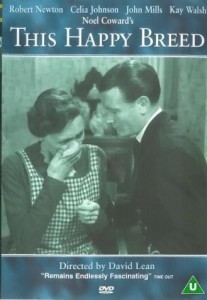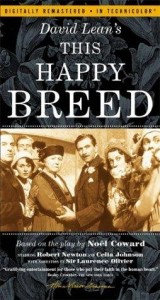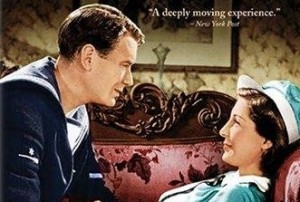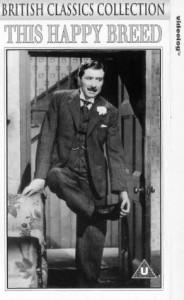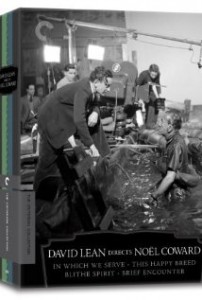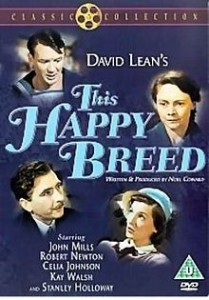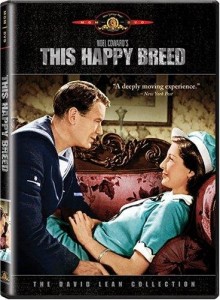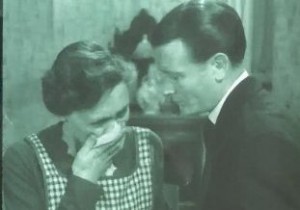This Happy Breed **** (1944, Robert Newton, Celia Johnson, John Mills, Kay Walsh) Classic Movie Review 1,677
Playwright Noël Coward makes a lovely attempt to show how ordinary, salt-of-the-earth English people lived between World War One and World War Two, in the 1944 British Technicolor drama film This Happy Breed.
Director David Lean, who also co-wrote the screenplay with producer Anthony Havelock-Allan and cinematographer Ronald Neame, makes a thoroughly professional job of bringing to the screen in 1944 Noël Coward’s 1939 play about a south London family called the Gibbonses.
Robert Newton and Celia Johnson star as the kindly, well-meaning working class married couple Frank and Ethel Gibbons. They have a son Reg (John Blythe) who is killed and a daughter Queenie (Kay Walsh), who has a fling with a married man but eventually goes for homely neighbour, Billy Mitchell, played by John Mills.
The film’s panorama of English suburban life from 1919 to 1939 is an archetypal Coward mixture of good-natured comedy, sharp wit, glowing nostalgia, heart-tugging sentimentality and wartime, moral-boosting patriotism. It’s a little bit shaky now, but warm, entertaining and full of fascinating, accurate-seeming period detail, and has a beguiling rosy-hued glow of nostalgia hovering over it.
The actors all give highly engaging performances, particularly Newton and Johnson, but also Mills, Walsh and Stanley Holloway as Billy’s dad, Bob Mitchell.
Coward co-produced the film of his play with and Anthony Havelock-Allan, while Neame made an outstanding piece of work of the glorious-looking Technicolor cinematography as well as, unusually for a director of photography, co-writing.
The title refers to the English people in a phrase from John of Gaunt’s monologue in Act II, Scene 1 of William Shakespeare’s Richard II: ‘This happy breed of men, this little world. This precious stone set in the silver sea.’
Lean’s fruitful classic partnership with Coward started with In Which We Serve in 1942 and went on to produce this, Blithe Spirit and Brief Encounter, a magnificent quartet of films.
Of the stars in In Which We Serve, Celia Johnson, Kay Walsh and John Mills all memorably appear in This Happy Breed, while Celia Johnson, Everley Gregg and Joyce Carey all memorably re-appear in Brief Encounter, along with Stanley Holloway.
This Happy Breed may be the least of the quartet but it’s still quite special.
It is Lean’s solo directorial debut after co-directing In Which We Serve with Coward.
Laurence Olivier narrates the introduction over an aerial shot of 1919 London: ‘After four long years of war, the men are coming home. Hundreds and hundreds of houses are becoming homes once more.’
Coward had played Frank Gibbons on stage and wanted to do so on film, but Lean felt film audiences would be unable to accept him in screen in the role because of his famous persona of witty sophistication. Lean offered the role to Robert Donat, who refused the role because he objected to his final speech, explaining in a letter to Coward: ‘I believe it is just that very political irresponsibility that got us into another war.’
Robert Newton took over, but was made to sign a contract forfeiting £500 of his £9,000 salary every time his drinking caused a delay in production. Neame said that by the end of filming Newton had forfeited his entire salary, although the producers paid him his full fee.
It was Lean who insisted on filming on three-strip Technicolor stock, difficult to acquire in Britain during the war.
The soundtrack, which includes Coward’s poignant wartime song ‘London Pride’, is performed by the London Symphony Orchestra conducted by Muir Mathieson.
This Happy Breed was the biggest British hit of the year at the box office in 1944 in Britain.
A restoration combining digital and photochemical techniques was carried out from March 2006 to January 2008 at the British Film Institute’s National Archive’s Conservation Centre in Berkhamsted and at Cineric in New York City. It includes correcting the colour and a full digital restoration of the picture and soundtrack.
The cast
The cast are Robert Newton as Frank Gibbons, Celia Johnson as Ethel Gibbons, Alison Leggatt as Aunt Sylvia, Stanley Holloway as Bob Mitchell, John Mills as Billy Mitchell, Kay Walsh as Queenie Gibbons, Amy Veness as Mrs. Flint, Eileen Erskine as Vi Gibbons, John Blythe as Reg Gibbons, Guy Verney as Sam Leadbitter, Betty Fleetwood as Phyl Blake, and Merle Tottenham as Edie.
© Derek Winnert 2014 Classic Movie Review 1,677
Check out more reviews on http://derekwinnert.com/

